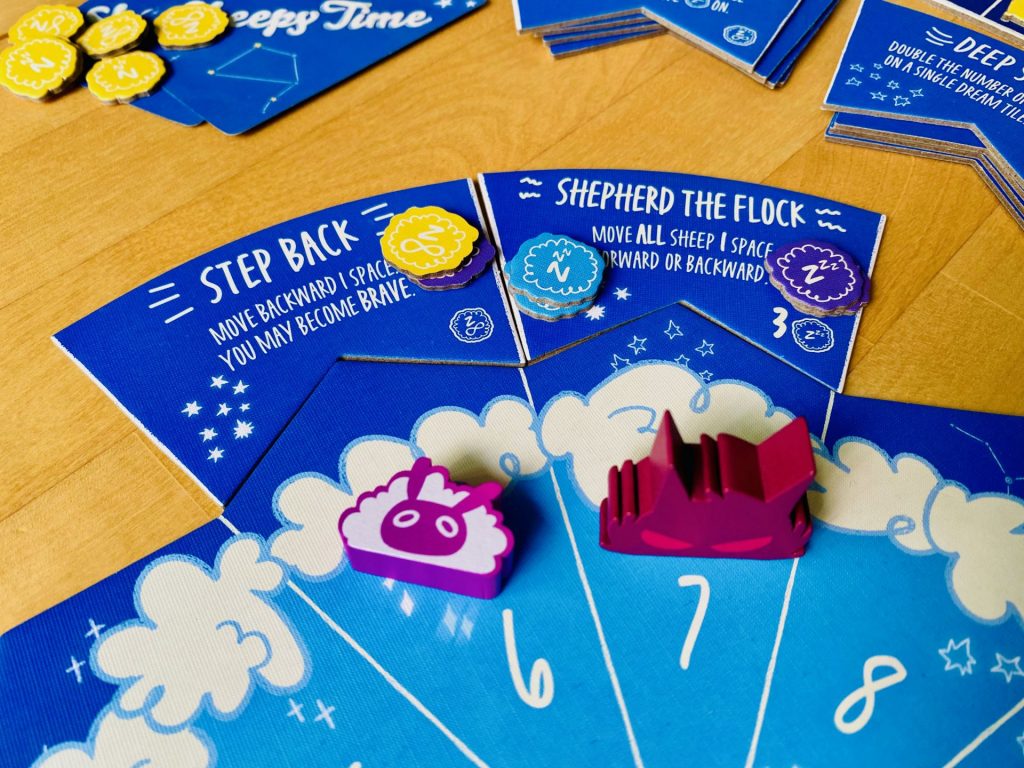How do you fall asleep when your head hits the pillow? Some people shut their eyes and are out like a lightbulb, others run through their day in their mind’s eye and those of us who are too amped up might need the help of the Dream Sheep, which we count to lull us to Dreamland.
Overview
Sheepy Time is an area movement, push your luck, racing game for one to four players. Players take on the role of the Dream Sheep and over the course of a few rounds, players race to jump the fence as many times over in order to help everyone have a good night’s rest before the Nightmare threatens to rudely wake everyone up.
The game is set up like so:

The game plays on a circular board upon which the Fence token sits. Players’ Sheep tokens, the Nightmare token, and the Web token, if used, are placed on the board. The score board is set up with the corresponding Pillow Reference card for different player counts. Each player places one Wink token at the start and one Pillow token at the end of the scoreboard. The Wink token keeps track of how many Winks players gain over the course of a round and their Pillow tokens show how much sleep players will need to complete a good night’s rest to win the game: exactly forty winks.
Players also receive ten Zzz tokens that are used to subscribe to special abilities on the Dream Tiles which fit around the circumference of the game board. If they land on a number with a Dream tile that has their Zzz tokens, these Zzz tokens award players special abilities, like extra movements. Lastly, the chosen Nightmare’s movement cards are randomly shuffled into the Sheep card deck and all players draw two cards to form their hand.

Game Play
Sheepy Time has an unusual game board shape for a Race-To-The-Finish game. Players are essentially lapping around a circle and jumping over the fence as many times as possible during each round of the game. On a turn, players choose one of two cards in hand to determine how far their Sheep tokens will move, clockwise, around the game board. If at any time players draw a Nightmare card (even at the start of the game), they reveal it and resolve the instructions for the Nightmare immediately. If they end their movement on a space with a Dream Tile that they are subscribed to, they may use the Special Ability and resolve it.
Many of the Sheep cards that players play to move their Sheep tokens come with additional options to use together or as an alternative to the movement it accords. Some cards state “Catch a Zzz”, which allows players to place one Zzz token on any Dream Tile. Other tiles say “Gain X number of winks”, which allows players to move their Wink token further along the scoreboard.
Each time players cross the Fence, they immediately gain five Winks and score by moving the Wink token five steps ahead on the scoreboard. Then they must decide if they want to Call It A Night, which is to retire for that round, or continue for another lap. If they retire, their Sheep token is removed from the board and their turns are skipped until all other players have also retired or have been Scared and Woken Up.

Let’s explain how being Scared and Woken Up happens. Any time a Nightmare card is drawn, it is immediately resolved. The card will instruct how to move the Nightmare token around the board. If a Nightmare moves onto or through a player’s space during its movement, that player must lay their Sheep token on its side to indicate that it is Scared. This itself has no drawback unless the Nightmare comes around again. If it happens a second time during the round, then the Sheep Wakes Up and returns his Wink token back to the start of the scoreboard and has not gotten any sleep this round.
The round ends when all players have Called It a Night or have Woken Up. Then scoring for the round begins. Players whose Wink token is farthest along (i.e.. got the most shut eye) are rewarded by moving their Pillow token up the scoreboard and closer to the start since they are more rested and need less sleep. Before the next round begins, players can choose to either select one of the four open Dream tiles to add to anywhere on the game board or place two Zzz tokens to subscribe to any of the Dream tiles on the board.
The player whose pillow is farthest away, and therefore needs the most sleep, gains the First player token. All the Sheep cards are reshuffled and dealt out again and a new round of play begins. The game continues in rounds until the player whose “head hits the pillow” (when their Wink token is at or past their Pillow token) first ends the game.Shee
Final Thoughts
I was honestly surprised at this gem. Initially I thought, “Eh, it looks like a cute kid’s game” thinking I would have to sit through mundane game play but, in fact, Sheepy Time sits comfortably in the Family weight category. The Sleeping theme and the Dream sheep were what drew my kids in and the components and design are unusual and creative. It’s the first time I’ve played a game that had us do laps around a circular board, in a First-to-Finish race – against the game. And as proof of how AEG took pains to make the game alluring, I am quite taken by the Fence token, which is a useless piece to actual game play but made the game more immersive.
The first few times we played Sheepy Time, my seven year old, who is a natural risk-taker, kept trying to race the Nightmare around the board without taking heed of the Nightmare’s placement. Many times she ended up being Woken Up when the Nightmare token crossed the fence and left her with nothing to show for her efforts. This was also true for the adults as well, as we got to learn the pace of the different Nightmare versions. I thought the seven year old would be frustrated coming up short so many times. But the Push-Your-Luck element in this game is captivating since success always feels like it is close enough to grasp. After all, there are only 10 steps from the start to the fence!

I wrote an earlier piece about a much smaller Push Your Luck game called Mandora Fever. The tension in that game is resolved very quickly each turn once players take action. In contrast, the tension in Sheepy Time is drawn out longer, through all the players’ turns and movement, as the Nightmare paces across the board at different speeds, which means players get more time to savor it. Different Nightmares change the tension of the game. The Bump In The Night Nightmare moves much quicker than the Wolf, while the Spider Nightmare slows down players no matter how fast they want to go! There are plenty of opportunities to relish the balance of tension between making a safe but less rewarding bet or risking it for big winks over the course of the 40 or so minutes it takes to finish a game.
Another reason our family enjoys the game is the social interaction it offers. The Nightmare impacts anyone along its way and not just the active player, so there is quite a bit of investment in all the players’ engagement and social interaction throughout the game. You are just as likely to bite your nails when your opponent draws his card as you would if you drew a Nightmare card on your turn. Every player is just as likely to be Scared or Woken Up each time the Nightmare moves.

The three nightmare options— the Nightmare Wolf, the Bump In The Night, and the Sinister Spider —means that there is quite a bit of variability. And with 10 Dream tiles to place around the spaces on the board from a stack of 30, there are so many permutations of abilities and hence replayability. I’ve played it seven times at different player counts including Solo play and keep discovering new combinations of Dream tiles which varies the game play immensely.
As a whole, strategies keep changing game to game depending on player count, Nightmare chosen and which Dream tiles are on the board. Each time, it takes a few rounds for the game board to be filled by Dream tiles since players may choose one at the end of the round or choose instead to subscribe to other Dream tiles already on the board. Then it takes yet a few more rounds before the strategies that the Dream tiles lend themselves to become apparent. All too soon, the game is over and our family is left wanting to play again so that they can test their newfound Dream Tile strategies or discover new ones they have not tried. But, by nature of the choices presented and the order of choices that players make as the game progresses, the next game will be different yet again.
If you’re willing to stay up for a Race-to-the-Finish, tension building, and Push-Your-Luck game about falling asleep, then this might be the dreamiest game yet. The only thing I really wished Sheepy Time did a better job of though is to actually get my kids to bed earlier.













Add Comment